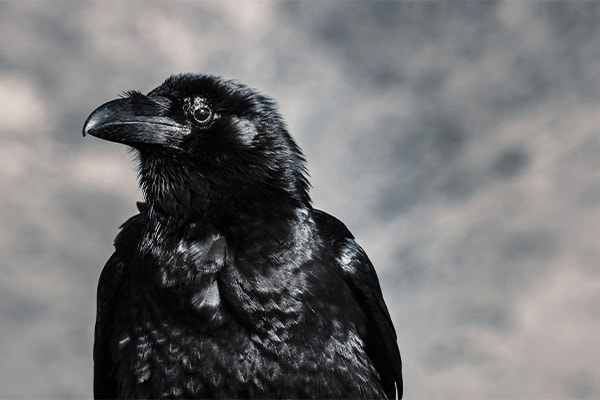
photo credit: Tom Swinnen from Pixabay
The American Crow is a well-known bird across North America. They are very intelligent birds. Their all-black plumage makes them very easy to recognize even from afar. You’ll often see them in large groups by the roadsides, treetops, fields, and other open areas.
In this article, we are going to cover a wide variety of topics related to the American Crow, such as:
- How to identify them
- How, when, and where they migrate
- Their diet
- How and where they nest
- And much more…
So, without any more delay…
Let’s jump right into it and learn more about the American Crow.
American Crow Facts
- Common Name: American Crow
- Scientific Name: Corvus brachyrhynchos
- Scientific Family: Corvidae
- Life Span: 7-8 years
- Size: 15.8 to 20.9 inches
- Wingspan: 33.5 to 39.4 inches
- Weight: 11.2 to 21.9 oz
- Conservation status: Least Concern
How To Identify An American Crow
American Crows are large-sized birds that are about 17 inches in length. They are known as the largest crow in North America, featuring a thick neck, long legs, a short squared-tail, and a straight bill. Added to that, their wings are broad and rounded. The birds showcase a glossy black plumage all over their body, including their legs and bill.
Differences Between Male & Female
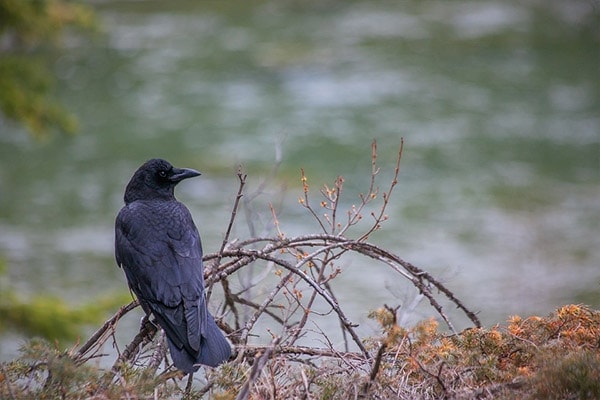
photo credit: Jasmin Sessler from Pexels
Male and female American Crows look identical, and there’s no way to tell them apart. Well, that is, unless a couple would sit together, you’ll notice that the male is larger than the female bird.
Differences In Summer Plumage vs Winter Plumage
American Crows don’t show any changes throughout the year, regardless if it’s summer or winter.
American Crow Sounds
Where You’ll See American Crows
American Crows are native birds in the Nearctic region and are widespread across North America. Their breeding range extends from the lower parts of Canada and across all of the United States down to Florida.
These birds are adaptable and can live in various habitats. However, it is observed that American Crows do prefer open areas with surrounding trees where they can perch. They also usually stay in places where they can find food sources like farmlands, city parks, rivers, pastures, backyards, and coastal areas.
During the breeding season, they prefer staying in forest edges.
American Crow Migration Patterns
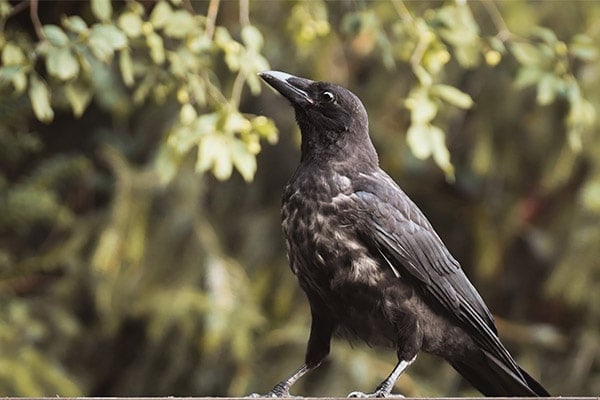
photo credit: Alexas Fotos from Pixabay
American Crows are resident or short-distance migratory birds.
Populations found all over the United States are resident birds and would stay in their territories all-year-round. However, birds that breed in the lower regions of Canada fly down south to the US for winter.
It is also observed that no American Crows are seen in Mexico during winter.
Diet and Feeding Preferences
American Crows are omnivores, which means they eat almost anything may it be animal or plant materials. However, the quantity they eat may differ based on the season.
When it’s the breeding season, American Crows would mainly eat various food, depending on what’s available or what they can find. They would eat insects, worms, berries, nuts and sometimes even hunt small animals like frogs, mice, snails, and snakes.
There were also instances when the birds would eat garbage, eggs, young of other bird species, and even scavenge on roadkill.
By the fall and winter seasons, American Crows would eat more nuts. They would also sometimes visit bird feeders.
Nesting Data
- Clutch Size: 3-9 eggs
- # of Broods: 1-2 broods
- Incubation Period: 16-18 days
- Nestling Period: 20-40 days
- Egg Description: Light blue-green to olive-green with brown and gray blotches on the large end
Nesting
American Crows are monogamous birds known to form long-term bonds, with several cases where offspring from the other year stay with their parents to help feed new young.
Once the breeding season starts, a couple would choose a nest location, usually in a tree or large shrub about 10-70 feet above the ground. They would build the nest in a corner near the trunk or on a horizontal branch.
The male and female birds help each other build the nest, which is usually made up of twigs and sticks lined with weeds, animal hair, feathers, and pine needles.
American Crow Behavior
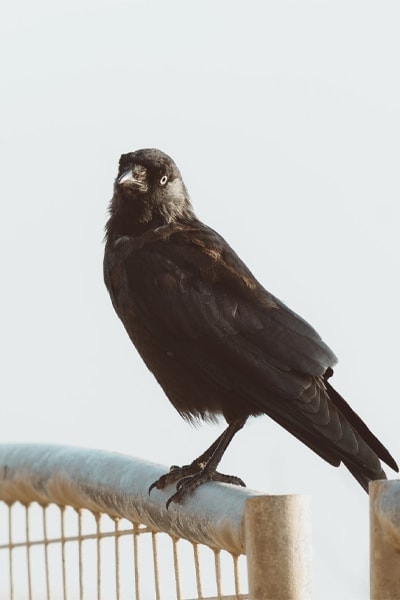
photo credit: JACK REDGATE from Pixabay
American Crows are highly social birds, normally staying in large groups. You’ll see many crows gathered together on perches and even help each other search for food.
During the breeding season, American Crows also form long-term bonds and stay year-round with their family. Offspring from the previous breeding season often remain with their parents to feed the next young, and it’s not fully understood why they don’t search for mates immediately.
Families would help each other in defending their territories and chasing predators away. And when winter comes, they stay in the same territory but would not be as aggressive as they were when breeding.
These birds also practice anting, where they let ants crawl on their feathers. Sometimes, they would even pick up ants and smear them on their feathers.
One feeding behaviour observed in these birds is that they also store food for short periods.
Tips for Birdwatchers On How To Attract American Crows
American Crows are not frequent visitors of bird feeders, but they will come if you provide them the right environment.
Make sure that you install perches for them where they can roost. Also, remove any potential source of sounds like wind chimes as they may startle the birds. Then, spread some of their favorite seeds on the ground like peanuts, pet kibbles, and even food scraps.
Install a birdbath, so they have water to drink or bathe into. And you can also place some decoy crows, both moving and stationary, to tempt crows to come. Then, you can buy yourself an electronic caller to call for them.
Once these birds start to identify your backyard as a feeding ground, they will surely keep coming back, so maintain it. You can also create a compost bin that the crows can rummage through.
Threats To The American Crow
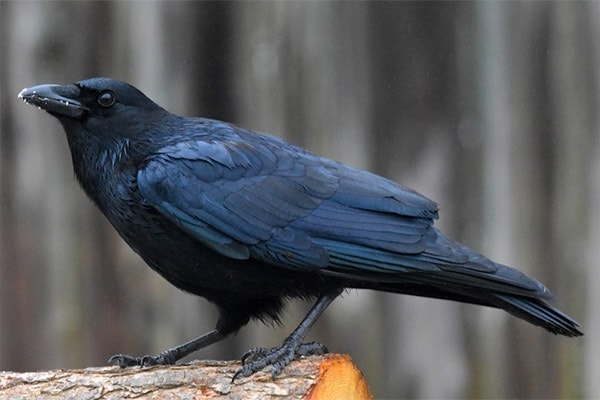
photo credit: Jack Bulmer from Pixabay
American Crows are widespread across all of North America, and their numbers remain to be stable. There are no significant threats. However, it is noted that the birds are highly susceptible to the West Nile Virus.
Crows are also hunted by predators like hawks, owls, raccoons, snakes, and cats. But it’s no longer a significant threat as American Crows would often help each other harass and chase away predators.
Fun & Interesting Facts
- Young American Crows do not breed until they are two years old.
- These birds can fly up to 30 miles per hour.
- These birds are highly susceptible to the West Nile Virus.
- American Crows’ bird call is very distinctive and is described as short series of “caw-caw-caw”.
- A group of American Crows is called “A Murder”.
- The oldest recorded American Crow was 16 years and four months old.
Explore More Species in This Family
- Canada Jay
- Green Jay
- Pinyon Jay
- Steller’s Jay
- Blue Jay
- Florida Scrub-Jay
- California Scrub-Jay
- Woodhouse’s Scrub-Jay
- Mexican Jay
- Black-billed Magpie
- Yellow-billed Magpie
- Clark’s Nutcracker
- Northwestern Crow
- Fish Crow
- Chihuahuan Raven
- Common Raven
The post American Crow: Bird Identification, Habits, Facts, Nesting appeared first on BirdInformer.com.
from BirdInformer.com https://ift.tt/3lQsN9H

No comments:
Post a Comment